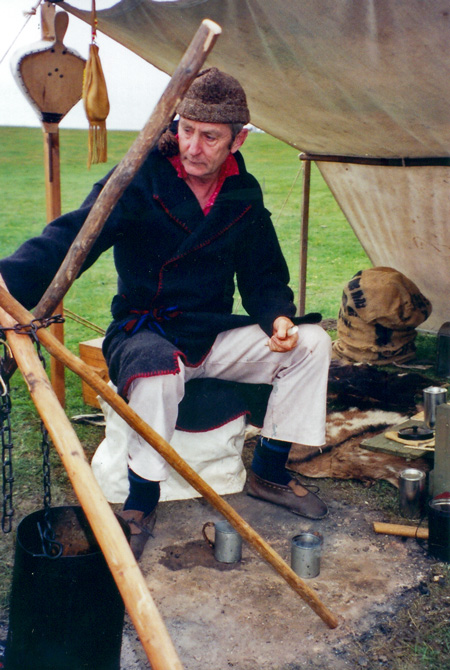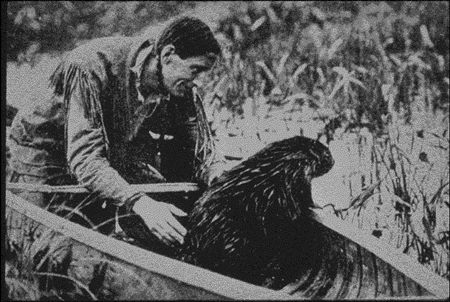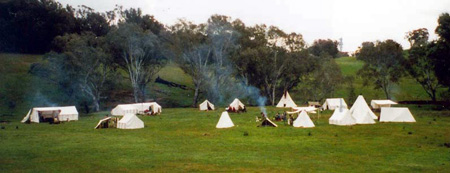Vol. 8, December 2007

Still looking after Murray – Ian Convey prepares tea for two. Sept 2007
Summer Workshops
So, how’re all your preps for the Holey Plains gold rush? Have you already adopted a persona that shines like gold? Are you a pick & shovel digger, a pan washer or a puddler? Or a fossicker with bowie knife and a sharp eye? Oh, I know two folks retraining at cradling. Perhaps you will be a rogue, a pick-pocket or sly grog seller?
Holiday Reading
Jenny Baker, our good friend from The Blue & the Grey, discovered this website with a pertinent article on a (relatively) modern Trapper, and with a few interesting facets on “developed persona”. Thanks to Jenny for the lead to this fascinating summer read.
Grey Owl (1931) http://www.pc.gc.ca/eng/pn-np/mb/riding/natcul/natcul2.aspx#go
“The safety of the beaver would be guaranteed as long as they would live,… Further I would be given every opportunity to carry out my conservation ideas in a dignified and constructive manner, without the necessity for anxiety as to the means … I myself would become a servant to the government of Canada” – Grey Owl in Pilgrims of the Wild 1935
Introduction
Grey Owl, the famous trapper – turned – conservationist, began work as a “keeper of native animals” on April 17, 1931 in the newly declared Riding Mountain National Park. He, and his pet beaver, Jelly Roll and Rawhide, would spend only six months in the park; however Grey Owl’s stay in Riding Mountain represented a significant turning point in his career and life.
Grey Owl is a legend, well known for his love of nature and his dedication to the preservation of wilderness. In the depressed world of the 1930’s, he received international acclaim as a great naturalist, a successful author, a gifted orator and a respected native spokesman.
Grey Owl’s Early Life
Grey Owl was born Archibald Stansfeld Belaney at Hastings, England on September 18, 1888. Abandoned by her husband, Archie’s mother remarried and left Archie to be reared by his two maiden aunts when he was 4 years old.
Because his father had gone to America, Archie grew up believing his father was living with Indians and as a child, he became fascinated by nature, wild animals, far-away lands and Indian braves.
After leaving school at sixteen Archie worked briefly in an office in Hastings but the lure of the wilds of North America was too much for him. On 29th March 1906 Archie Belaney boarded the steamship SS Canada bound for Halifax.
In 1907, after spending some time in Toronto, Archie ended up working at a small resort near Temiskaming in Northern Ontario. Here, he gave himself a new history, growing up an Indian in the America southwest, the son of a Scottish trader and an Apache girl.
In Temiskaming, a native prospector took Archie in and trained him as a wilderness guide. He learned the language and ways of the Ojibway people. In 1910 he married an Ojibway girl, Angele. But Archie, like his father, was prone to wander. In 1912 he left Angele and guided, trapped and worked as forest ranger in various locations in northern Ontario.
In 1915 he Archie ended up in Nova Scotia, enlisted in the Canadian Army and was sent overseas to France during the First World War. He was wounded there and returned to England to convalesce.
In England, Archie married his childhood sweet-heart, Constance Holmes. They were soon divorced, as after his discharge from the army, Archie headed back to the northern Ontario wilderness.
Back in the bush, Archie was befriended by another Ojibway family and he leaned more and more towards the Indian lifestyle. Clad in buckskins with his dyed black hair hanging in braids, he became known as Wa-Sha-Quon-Asin (He-who-walks-by-night) – Grey Owl.
Grey Owl’s Conversion
In 1925 he moved to northern Quebec where he continued to trap and guide. Here he met and married a young Mohawk girl, Gertrude Bernard. He called her Anahareo and she would play a major role in changing his lifestyle from trapper to conservationist and author.
When two beaver kittens were left orphaned because their mother had died in one of Grey Owl’s traps, Anahareo convinced Grey Owl to rescue them. The two orphans were adopted and named McGuiness and McGinty.
In 1929, Grey Owl and Anahareo moved to a place near Cabano, Quebec where they hoped to establish a beaver colony. At this time, because of over-trapping, the Canadian beaver population was reaching near extinction.
The orphan beaver had left Grey Owl more concerned with finding ways of protecting beaver than in devising better ways of trapping them. The two beavers stayed with Grey Owl and Anahareo for about a year and than disappeared.
While in Cabano, Grey Owl had his first nature article published in the British magazine called “Country Life”. This led to requests for more articles, a book and lectures. Grey Owl moved on to a Quebec resort town called Metis-Sur-Mer and he soon became known for his tales as well as his new beaver kitten, Jelly Roll.
Coming to Riding Mountain National Park
Grey Owl was becoming well known across the country as the “beaver man”, and in February, 1931, he was offered employment as a naturalist in Riding Mountain National Park. The national park system felt that his beaver conservation work and his positive publicity would be beneficial to their program.
By this time Grey Owl had acquired a mate (Rawhide) for Jelly Roll. He accepted the position but declined an offer to visit the park to select a site for his new home. He dared not leave while Rawhide and Jelly Roll were under the ice in a “country swarming with illegal hunters”.
After several months of writing letters back and forth, the Park staff of Riding Mountain selected a site that met with the requirements of Grey Owl.
“I would clear a trail to any selected place. Isolation means nothing to me, beyond what accessibility is necessary to allow for the carrying out of any project such as demonstration or the taking of moving pictures, inspection, etc.”
Grey Owl to Riding Mountain Park Superintendent, March 2, 1931.
On April 17, 1931, Grey Owl, Jelly Roll and Rawhide arrived by train in Neepawa, Manitoba and were transported by truck to a small lake, seven miles northeast of Wasagaming.
The beaver arrived in good condition, having made the 2000-mile; weeklong train trip in a large galvanized sheet-iron box. This box had been specifically designed by Grey Owl to resemble a real beaver lodge, with a water-filled swimming tank, a drying platform and raised sleeping area. Upon release, the beaver immediately took to the water and explored the lake.
“Well sir, this was some trip. The beaver made the grade and are now happy and contented with two beaver houses, in a land of coyotes, elk, jumping deer, and some darned good view…. The Parks people, who have been wonderful to us, are building a palatial house for us near the beaver….I want to tell you the world is a different place this last few months mister.” – Grey Owl to his friend, Spring of 1931.
In Riding Mountain
The lake were Grey Owl and his beaver were installed became known as Beaver Lodge Lake and a cabin was built on the lake’s edge by Park staff. The cabin, which was divided into two areas (a main room and an annex), met the needs of both Grey Owl and the beavers. Entranceways were made in the main room so that the beavers could come and go as they wished. Grey Owl often found Jelly Roll and Rawhide curled up beside him as he slept, safe in the protected wilderness of a National Park.
The Park staff provided the necessary supplies to insure that both Grey Owl and the beavers were content in their new home. A special chestnut canoe was purchased so Grey Owl could paddle around the lake and watch for beaver activity.
Now that Grey Owl and his beavers were settled Grey Owl began his work with the beavers and the public in earnest. His job was to re-establish beaver colonies in areas where they were exterminated. It was also thought Grey Owl would attract visitors to this new park with his tame beaver and his dynamic personality.
In the spring Grey Owl obtained some new beaver kittens and Jelly Roll gave birth to four new kittens. Grey Owl became pre-occupied with training the young and adult beavers. The training was done during the night when the beavers were active. Grey Owl slept from 5:30 am until 12:30 noon then rose to greet visitors. His days were filled with caring for the beaver as well as two sets of elk and moose that had been placed in his care. On several occasions, Grey Owl would come into the townsite of Wasagaming and tell a few stories at the Wigwam Restaurant.
Although Grey Owl did not have time to continue his writing while in Riding Mountain, two sets of movies were filmed and he posed for a number of still shots with Parks photographer Bill Oliver. Used in his books and on his lecture tours, the photo’s and film’s taken during his time in Riding Mountain would make him famous and spread his message around the world. Visitor Centre staff can show you his 1931 Beaver Family movie.
Leaving Riding Mountain
“It was an ideal beaver pond and they were well established; if there had only been sufficient water for their migrations and to satisfy my bull headed ideas for a canoe” – Grey Owl from Prince Albert Nat’l. Park to Riding Mountain Superintendent 1932

Grey Owl and his pet beaver Jellyroll – Photo courtesy Parks Canada
1931 was a drought year in Manitoba, and in July, the water in Beaver Lodge Lake had gone down by two feet. Grey Owl stated that the conditions (shallow water table and little snow) did not make Riding Mountain suitable for the beaver. That in future years, when the beaver population had increased and the young beaver were forced to move on, there would not be enough water for their travel.
Grey Owl was also upset because, several of the young beaver Grey Owl had been training had died. Being an avid and skilled canoeist, Grey Owl also found little comfort and enjoyment at the isolated slough that was Beaver Lodge Lake.
Grey Owl requested a transfer west, and on October 26, 1931, together with Anahareo, Rawhide, Jelly Roll and four beaver kittens (Wakanee, Wakanoo, Silver Bells and Buckshot), he left Riding Mountain National Park and arrived safely at Ajawaan Lake in Prince Albert National Park.
Grey Owl would spend seven years in Prince Albert National Park completing his major literary works. The last two years of this time was spent touring and lecturing in North America and England.
On April 13, 1938, Grey Owl died of pneumonia. His body was laid to rest on the hillside overlooking the cabin on Ajawaan Lake.
Conclusion
Grey Owl will always be remembered in Riding Mountain National Park as “keeper of native animals”. He launched the first beaver conservation project in the Park and partly because of his efforts Riding Mountain now has an abundant beaver population.
Despite Grey Owl’s dissatisfaction with Riding Mountain National Park, his six-month stay here would be an important turning point in his life. It was a time when he fully embraced his public persona as Grey Owl, “protector of the Beaver People”. It was the first opportunity he had to carry out his beaver studies in a protected environment. It was also the beginning of his life in western Canada, a period that would bring him fame, recognition and financial security.

Grey Owl’s Cabin Today
Grey Owl’s cabin on Beaver Lodge Lake still stands, a tribute to the skills of early Park staff and craftsmen. Grey Owl’s cabin is a popular destination for hikers, cyclists and cross-country skiers. The 17.8 km return trip off Highway #19 is a quiet trail that passes through a forest of aspen, balsam poplar, jack pine and white spruce. Displayed at the cabin are photos, letters and correspondences from Grey Owl’s stay in Riding Mountain National Park. The cabin was recognized as a Federal Heritage Building on November 17, 1988. If you look closely you can see where Grey Owl’s beaver chewed into the cabin walls.
…Just the same I am kind of lonesome for the little old pond, for all I was in such a hurry to get away from it.
-Grey Owl from Prince Albert National Park to Riding Mountain Superintendent 1932
Books By Grey Owl:
The Men of the Last Frontier , 1931
Pilgrims of the Wild, 1935
Adventures of Sajo and Her Beaver People, 1935
Tales of an Empty Cabin, 1937
Book of Grey Owl, 1940
Books About Grey Owl:
Devil in Deerskins: My life with Grey Owl, Anahero, 1972
Wilderness Man: The Strange Story Of Grey Owl, Lovat Dickson, 1973.
From The Land of Shadows: The Making Of Grey Owl, Donald Smith, 1990.
Grey Owl: The Mystery of Archie Belaney, Armand Ruffo, 1997.
Grey Owl: The Many Faces of Archie Belaney, June Billinghurst, 1999.
DVD –  Grey Owl
Grey Owl
Random Diary Notes
1774 Captain Patrick Ferguson began designing his breech-loading flintlock rifle. He subsequently demonstrated it before the King at Windsor, and before ordnance officers at Woolwich, authorising orders for 100 rifles.
1777 Ferguson had supervised the manufacture of the rifles and then trained a company of men in the use of his rifle, before sailing with the men to America.
1780 Ferguson who had attained the rank of Lieutenant Colonel was killed in action at King’s Mountain on 7th October, his rifle design subsequently abandoned by the army. It was, however, copied by gunsmiths who made many beautiful guns for private sale.
For Sale / Trade
Readers interested in a quality custom made Ferguson should contact the secretary for further details on this hard to find firearm. Photographs available.
Tattler
An unexpected pleasure out of the wide blue during November, I enjoyed a Telecom style Rendezvous with Bill Wilson. Bill and wife Beryl live up Bundaberg way – the home of fine rum, drop bears and girls that camp. I do carry on, don’t I?
I had met Bill and Beryl at the Fraser Coast Rendezvous back in 2004. My voyager cap still sports a nice Rainbow Creek Muzzleloaders keepsake given me by Bill. Anyway, it seems Bill and Beryl were having a little tidy-up and Bill thought I might appreciate a looksee at some older Rondyvoo videos that he’d had stashed away. Would I ever! – There are always some new tricks to learn from the old days.
We exchanged news, and as Bill and Beryl are not into mod fads like computers, it was my pleasure to mail copies of all our newsletters, just so they could see how well you pilgrims have been travelling lately.
Simultaneously, Bill forwarded a small collection of videos together with several pair of period style spectacles. These later will be available on a trade blanket with proceeds to our club kitty, while I will endeavour to transpose the video material to DVD to make copies available to interested members. Bill also has that beautiful custom made Ferguson breech loading flintlock for sale – details of which I emailed members at the time.
Our thanks to Bill and Beryl for sharing the pleasures of Rendezvous – we wish them both good health and continued shining times through the years ahead.
It’s no rumour that Norrisville Trading Post had bundles of diapers on display among the concrete totems. Not for trade though, as Kev and Robyn are now the proud grand parents of a beautiful baby girl named Elizabeth. Congratulations all around!
Events for 2008
March 21st – 24th Easter at Rosedale. Just this once we depart the American streams and woods to support gold seeking Colonial friends. There are fortunes to be won and lost and mountains of fun to be had as we adopt new personas and learn new trades.
June 7, 8 & 9th long weekend. A time machine magically returns us to the pre 1840 American wilderness. We return also to the magic allure of Bernard’s Cache at Caveat.
September, Sat 20th – Sun 28th Spring Rendezvous coinciding with the first week of the Victorian school holidays. We push through hostile Crow lands and over the Wind River Range to “Beaver Creek” below the mountain called Buffalo.
And looking quite a bit further ahead to June / July 2009. We plan to rendezvous at the Australian capitol – Millmerran, Queensland. That’s 10 days, plus extra for travel.
Important message to ALL licensed firearm users
New firearm regulations came into effect late 2007. It is strongly urged that you make yourself familiar with all aspects / changes. It is also suggested that you diarise a personal memo for some weeks before the due date of your license, and ensure that you receive and process the renewal documentation well BEFORE the expiry date. Believe me; you will not want the hassle should Licensing Branch for any reason not receive your renewal application by the due date.

Beaver Creek Camp, Sept 2007